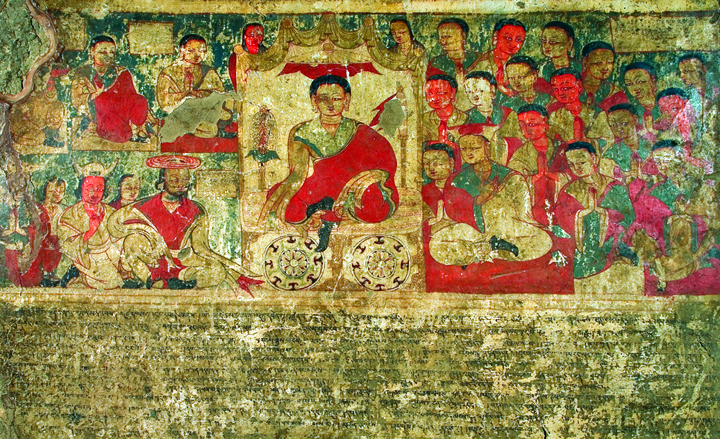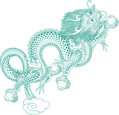Yeshe Öd the law-maker
Lha bLa ma Ye shes ’Od, ruler of Western Tibet in the late tenth century, is well known for his efforts to promote Buddhism, suppress Bon, and stamp out inappropriate ritual practices. He was also a law-maker.
Laws have not survived from his time, but a biography, written four centuries later, is shot through with references to khrims. [1] It indicates that for Yeshe Öd, law-making was a means to protect religious institutions, maintain peace, promote the moral conduct and happiness of his people, and ensure correct behaviour among monastics.

As his biography describes, before resigning as king and taking religious vows, Yeshe Öd creates law and presents the khrims gnyis, two laws, to a great assembly. Later, he gives repeated instructions to his successors about how they should create and follow law. They should, for example, ensure that power is not fragmented and is exercised in accordance with the old royal laws (rgyal khrims); edicts should be made to ensure that religious establishments and their inhabitants are supported and the doctrine is spread;those who break the law must be punished appropriately; literacy and virtue must be promoted, and so on (fols 13a–14b, 31a–32a, 33b–34b, 35a–b). When they make new laws, he says more than once, rulers should respect the ancient laws of their forebears, the advice found in Indic texts, and his own, more recent, laws (fols 25a–b, 26a). Laws, that is, are the means by which rulers should govern. They are also supposed to enshrine moral principles.
In a fine analysis of this text, Jacob Dalton (2015) describes the way in which it articulates (new) ideas about the relationship between religion and state. It emphasizes a distinction between the two, and indicates a supportive relationship, encapsulated in the idea of lugs gnyis, two systems. This reflects a long tradition in Indic writing, whereby the activities of king and priest are distinct, but complementary. In Tibet, this relationship becomes explicit two centuries later, in the ideas by which Tibetans represented their relations with the Mongolian rulers: the Mongol king as the patron of the Tibetan priest. As Dalton convincingly argues, a separation between the two realms of activity is already apparent in the biography of Yeshe Öd.

© CPR Environmental Education Centre, Chennai
Looking even more closely at the references to law, I suggest, can add both support and nuance this view.
Firstly, the reference to khrims gnyis, two laws, is reflected in two distinct types of rules. On the one hand, there are the chos khrims, tshul khrims, and dge ’dun gyi khrims. These terms are all used to describe rules for monastics, and they are presumably rules of discipline. On the other hand, there are the khrims lugs or khrims yig, in general. These terms seem to refer to rules that apply to the laity (see, for example, fol. 30b, for the distinction between the two). The domains of monastic and secular activity, that is, are distinguished by the different laws that apply to those within them.
Secondly, both types of law have broadly moral and religious purposes. As the text makes clear, lay people are expected to engage in religious practice, and the khrims should guide them towards virtuous conduct (fols 30a–b, 33b–35b). This is very different from imperial laws (see original blog post).* In Dunhuang documents khrims were practical judicial and administrative rules; they specified amounts of compensation, distinguished types of offence, and made procedural rules for litigation. They were primarily directed towards the resolution of conflict and the management of commercial activities. For Yeshe Öd, khrims are tools of government, but they are firmly associated with the promotion of moral conduct. We should probably assume that by the time he came to power the management of conflict and disputes had become very localized, the centralized judicial system of the empire had disintegrated, and its complex rules had become anachronistic. Law is now the basis for the moral order that Yeshe Öd is seeking to establish in Ngari.

Thirdly, in many respects, Yeshe Öd is collapsing the distinction between the functions of king and priest. He gives orders for the suppression of dubious ritual practices and the punishment of those who transgress these directions (fol. 28a–b, 34a). Religious activity is, to a significant degree, his responsibility. He also makes it clear that the monks need to respect the ruler’s khrims as well as their own rules of discipline (fols 25a–b). Dalton suggests that the king, himself, will be restrained by the ethics of the law. He must certainly act morally, but on this account he is also the supreme law-maker.
The distinction between religion and state is, nevertheless, important and Dalton is quite right to highlight its emergence in this text. Here I have suggested that the distinction is reflected in two types of laws—for monastics and the laity. A similar distinction is made in later historical narratives, which refer to chos khrims and rgyal khrims. It is central to the ways in which Tibetans later presented the nature of their polity.
Sources
Gu ge Pandita Grags pa rGyal mtshan, Lha bla ma Ye shes ʼOd kyi rnam thar rgyas pa bzhugs so. Do rgya dbang grag rdo rje (ed.) 2013. Lhasa.Bod ljongs mi dmangs dpe skrung khang.
The manuscript can be found at TBRC: W1PD153537, v. 13, pp. 283–365.
References
Dalton, Jacob. 2015. Power and Compassion: Negotiating Buddhist Kingship in Tenth-Century Tibet. In O. Czaja and G. Hazod (eds), The Illuminating Mirror. Weisbaden: Dr Ludwig Reichert Verlag. pp. 101–18.
Notes
[1] Lha bla ma Ye shes ʼOd kyi rnam thar rgyas pa bzhugs so was written by Grags pa rGyal mtshan in around 1480. As a historical account, the content and style must have been influenced by the writer’s own background. However, it seems that he lived and worked in the monastery of Tholing, founded by Yeshe Öd, and probably had access to original sources (Dalton 2015: 102).




